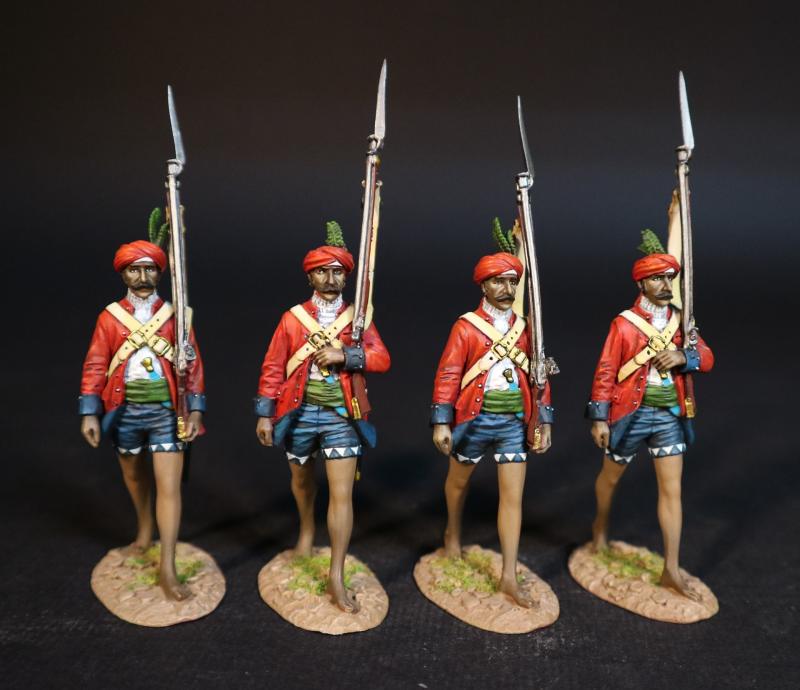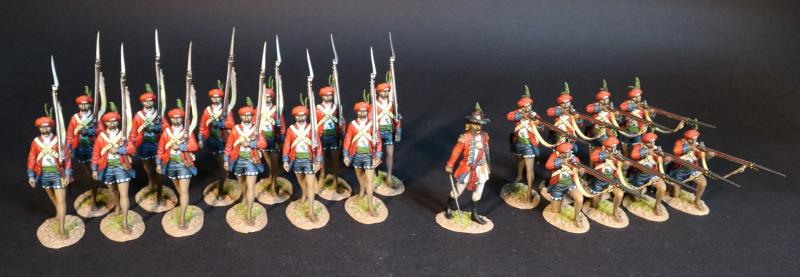Four British Sepoys, The British Army, The Battle of Wandewash, 22nd JANUARY 1760, The Seven Years War, 1756-1763--four figures
$162.00
Item Number: WBS-02N
Four British Sepoys, The British Army, The Battle of Wandewash, 22nd JANUARY 1760, The Seven Years War, 1756-1763
THE SEVEN YEARS WAR
THE THIRD CARNATIC WAR 1756-1763
THE BATTLE OF WANDEWASH, 22nd JANUARY 1760
The Battle of Wandewash was a confrontation between the French under the command of The Comte de Lally, and the British Sir Eyre Coote. It was the decisive battle in the Anglo French struggle in southern India during the Seven Years War.
Lally, cut off from sea support by the withdrawal of Admiral d'Aché fleet and hampered by a lack of funds and by dissensions among his troops, tried to recover the fort of Wandiwash near Pondicherry. There he was attacked and routed by Coote, with about 1,700 British troops against about 2,000 French. Lally’s best general, the marquis de Bussy, was captured. The French were thereafter confined to Pondicherry, which surrendered on Jan. 16, 1761, after much privation. Lally was later imprisoned and executed, after a trial in Paris, for alleged treason
The following two British regular units served in India and were present at the battle of Wandewash. It should be noted, however, that it was rare for these units to serve as complete battalions, and that they were generally broken up into detachments.
The British 79th Regiment of Foot, was raised in November 1757, originally as the 64th with drafts taken from the 4th, 8th, and 24th foot, but was later re-numbered during the shake up after various second Battalions were taken into the line. The regiment was to mainly see service in India from 1758, and was disbanded in 1764. Its commander was Major Brereton
The 84th (Coote’s) Regiment was raised in January 1759, specifically for service in India. The regiment was ordered home to be disbanded in 1764, but was instead reduced in India and most of the personnel were to enter the East India Company service.
Initially, the Madras European Regiment were not conventionally organized infantry battalions. Their organization, or what there was of it, resembled that of the marines, serving in effect as a pool from which more or less ad hoc companies and detachments could be formed for specific tasks.As long as the East India Company’s need was for purely defensive forces, tasked with watching over its factories and escorting merchants and officials this informal organization was adequate.
BRITISH SEPOYS
At the outset native units were in effect mercenary bands, recruited, equipped and led by their own officers, and generally referred to as Peons. By 1750, the East India Company were training and equipping their native soldiers in European fashion, and distinguishing them from the earlier rabble by using the term Sepoys instead.
In Bengal the first permanent unit of Sepoys was formed by Clive in early 1757. Clive dressed the Bengal Sepoys in red, which was also adopted by the Madras units in 1759.
Released in JUNE 2024.

